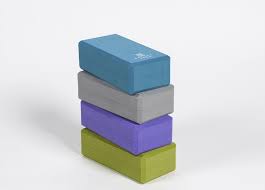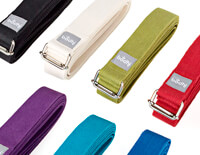Sthira sukham asanam- how to use yoga props
- Eleanor Chitham
- Nov 14, 2020
- 6 min read
Updated: Dec 1, 2020
To get the best out of your practice learn to use props. The first in a series of articles.
'What are the best yoga props?' together with where to buy yoga props online are the questions I'm most often asked now we're not sharing them in class. Some people want to know the best yoga props for beginners and why we use them at all. This introductory post will give you a few ideas and make some recommendations.
Have you ever noticed that there are poses you really struggle with that other seem to find so easy that they’re almost getting nothing out of them? The fact is everyone’s anatomy is different and even if you are fit and healthy there are some poses that will be tricky. This is normal as the world is a very diverse place. But what about equality? Iyengar was the first yoga Guru to make yoga inclusive. Even though I am not an Iyengar teacher, I went to Iyengar classes for years and learnt so much about using props as a matter of course in a class. Using props doesn’t mean that you ‘can’t do a pose’, it just makes poses more accessible to us all and helps us more easily find our ‘edge’. Judith Lasater built on this work and I learnt a lot from her on her restorative yoga course Relax and Renew. Patanjali’s famous Yoga Sutra 2.46 ‘sthira-sukham-āsanam’ remind us to look for steadiness (sthira) and ease (sukha) in each pose and props help us to this. We used to chant the sutra at the beginning of each session on our 5 day course.
The fact is I’m passionate about props and want to clear up a few misconceptions about why you should be using them. I use them in my asana practice daily. Iyengar made use of every day items around the Indian home; a luggage strap, a brick and the ubiquitous bolster which is used on beds and to sit on to this day. These items then became part of the yoga student’s toolbox and yet many people ask me where we can source them and how we can use them in our practice. If this is you, read on. I’ll also be covering this topic in more detail in other posts.
Yoga blocks and bricks- what's the difference?
Blocks resemble the shape of a large book whilst bricks look just like the name suggests. They are the shape of a house brick. Iyengar used wooden ones but they are now generally made of plastic. They have a multitude of uses but can be used to give support and help you reach the floor. I famously joke in classes about my short arms but the truth is that I am able to do some poses more effectively because I can root down to rise up with my hands on blocks. In other words, my arms are longer and I can open up the body when I press down. You might use a block to support your arm in a twist or a lunge. I always use one under the thigh in pigeon pose (Eka Pada Rajakapotasana). It’s a powerful hip opener and the block gives you support.

How to use a yoga block in Malasana (Garland Pose) to help open the hips
Try using a brick in Malasana (as shown in the photo if your heels don’t reach the floor and the pose is suddenly transformed from a balance to a hip-opener. Sitting on blocks is also brilliant when our hips and hamstrings are a little tight, as most people’s are. Bricks can also be used to raise other props, for example, raising a bolster in many reclining restorative poses. The last great thing about them is that bricks are versatile- they have 3 edges, long, medium and short. Just like the 3 bears! As you ease into a pose, you can turn a brick to make it shorter. With blocks you can use them in a similar way starting with 2 (or more!) and removing one as you breathe into the pose and your fascia relaxes.
Yoga Belts (Straps)
Belts- or straps- are great and I use them a lot too. They can be uses to hook your feet in many poses; in forward bends like Paschimottanasana and Janu Sirsasana a belt will prevent you from straining to reach your feet, allow you to find a little more space from pubis to solar plexus and hinge forward without damage. The belt brings your feet a little nearer! Belts can also be used to open up the shoulders in poses like Gomukhasana and when forward bending, especially when your feet are wide, as in Prasarita Padattonasana. You can also use a belt to feel more grounded and anchored in poses like legs up the wall (Vaparita Karani). This takes a little effort to tie though if you are on your own!
Yoga belts are especially great in forward bends to extend the arms. They are a really good addition in any practice where you want a longer hold in order to let the fascia release
Yoga Bolsters
Bolsters offer the ultimate ease and if you want to go deeper into your practice you should definitely own one. You can lie over them in many different ways and they are ideal for yin and restorative yoga. I would not be without mine for meditation. A zafu (meditation cushion) is great, but a yoga bolster is more versatile. You've probably already discovered that if you're not comfortable in meditation, you can't possibly connect to your inner stillness! To find ease, our hips really should be below our knees and for most people this is hard to achieve. A bolster will raise you up and allow the hips to gently open. If there’s still a small gap between your knees and the floor, you can always pad up with cushions. The reason for raising the hips is we can stay longer in neutral pelvis, respecting the natural curves of the spine and letting it lengthen, instead of bending forward which eventually will bring great discomfort. For extra comfort, sit on a comfortable blanket and make sure you are warm.
Where to buy yoga props ethically online
So what’s the best place to buy your yoga props online ? The yoga industry is confusing because though most yoga students are conscious of green and ethical issues, we do not always think about the origin of the things we buy. The lockdown has taught me that we really do need to support small businesses in the way you are continuing to support me as a local yoga teacher. Of course, it's often easier to go to the obvious online supplier we all know, but I am trying to be more conscious when I buy. It's a start. At the moment there are two brands in the UK that stand out to me and so I have partnered with them.
Yoga Bliss are a small company based in Hertfordshire in the UK who go the extra mile with their customer service and sell some beautiful and or products, many of which are
made in India. It’s like a treasure trove! If you source from them you know that you are supporting a local business. I really love these cork bricks, they are lightweight but supportive and would be my first choice if looking for bricks now. I bought 20 used
ones when I did my training with Judith Lasater, which helped the environment, but these are far superior! Click here to explore the Yoga Bliss website.
Ekotex is also a small company. They are based in Edinburgh and produce a simple range of affordable yoga equipment, produced with the environment in mind. They also aim to use minimal packaging. When you read their information, you can see they are really ethical and so they also get my vote. I really love this yoga bundle to get you started with your practice and their use of beautiful subtle colours is very appealing. They really do have a wonderful range of products so take a look. Click here to see their website.
There's lots more on this subject to come, because I'm passionate about props!
This post may contain affiliate links, which means I may get a small commission if you click the links and make a purchase at no extra cost to yourself. I only ever endorse products I fully believe in. Thank you for your support.
























Comments